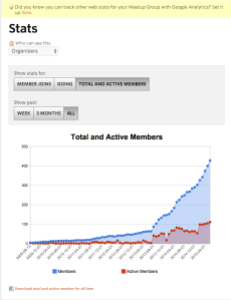My wish list for Meetup as a user group leader (thanks Meetup)
NOTE: This post is updated at the end with a very quick response from Meetup.com (Thanks!)
Warning: this is a rant. I’m currently writing an Agile2015 experience report telling the history of AgileFlorida.com and AgileOrlando.com specifically. Meetup.com was a key element of our success, but there are some things that frustrate me about Meetup with a rapidly growing user group.
 In this post, I’ve attached one of the current charts you can get from Meetup under the Stats menu. This is cool to see the dramatic growth over the last few years, but is this data actionable? For instance:
In this post, I’ve attached one of the current charts you can get from Meetup under the Stats menu. This is cool to see the dramatic growth over the last few years, but is this data actionable? For instance:
- Where are these people located so I know if I need to plan different locations across town?
- How many people are NOT in my region (and there are several) who do not have a group like ours but are interested in our topics? Should I start investing time and money in some virtual events or directing them to groups that might be closer to them?
- What other groups are they members of so I can reach out to groups where I see large overlap and suggest some collaborative events?
- How many are just lurking? Are these lurkers just curious? Are they recruiters? (if so, they may be potential sponsors or be able to help members looking for jobs) Are they wanting to promote a product or service to our group? (this could be good or bad and I’m very cautious as an organizer what info I pass on)?
- How many have accounts on Twitter, LinkedIn, G+, or Facebook? Then we will know where to amplify our efforts to put out group information and reminders on those social media networks. Not everyone will catch email reminders in time.
A little over a year ago (when we had 150 members), I could download abbreviated user profiles with raw data in one spreadsheet. It would give me all of the data in the new charts shown in the figure, plus some of the data in the points I list above. The rest I could fill in by going through member profiles (tedious, but insightful). I could generate any chart I needed via spreadsheet. With the new Stats area on Meetup, I seem to have less information which makes it very frustrating for managing a very rapidly growing user group. If I’m missing something, please let me know … really.
And now for something completely different: As a user group organizer for MANY years, I can say Meetup.com has been one of the keys to our success at AgileOrlando. It provides some great resources to help build community. However, the “analytics” are becoming frustrating for a group trying to apply lean startup concepts to identify different types of users and plan on ways to deliver value (see my community canvas talk for more details; fyi – data for that talk collected from Meetup.com, Twitter and LinkedIn in Dec 2013).
Help me Meetup-wan Kenobi (if you are out there). I need some hope to deliver better value to my members.
— A frustrated volunteer leader
Meetup was good enough to respond that same day via Twitter. Here are their answers:
meetup_support
@mkilby Thanks! #1 & #2 can be found by exporting your member info. Meetup page > Member page > “Download member list” (1/4)
@mkilby: that was a face-palm moment for me.. I’m used to seeing everything under the Settings menu. Would still be good to find it there.
@mkilby #3 is limited due to member privacy options. You can check with your members via mailing list email or face-2-face discussion (2/4)
@mkilby #4 Lurkers are tricky, you could infer that from ‘Last visited group’ versus ‘Last Attended’ on the member list. (3/4)
@mkilby #5 Good point, there isn’t a easy way to gather that for your members. It’s listed on their profile, but isn’t aggregated (4/4)
@mkilby Certainly, these are all great suggestions. We’ll be sure to share it with our Design and Data Teams here.
@mkilby: It’s not often I rant publicly, but I appreciate the quick response from @meetup_support
